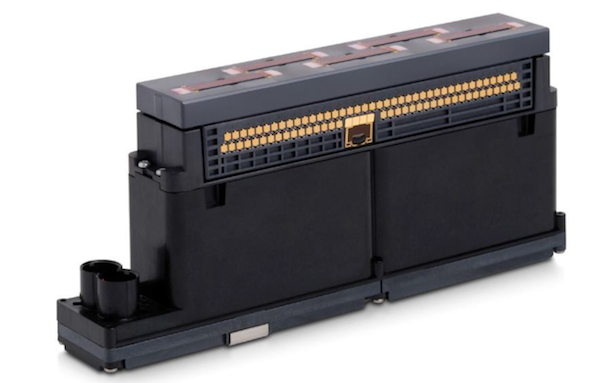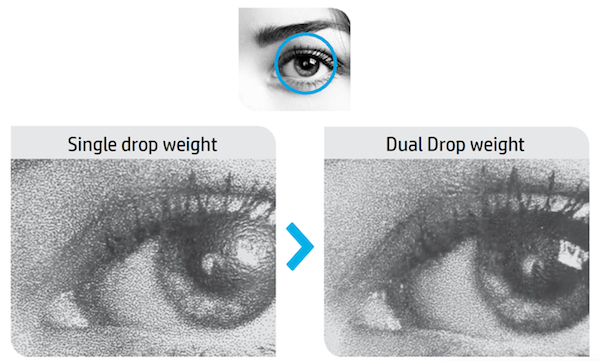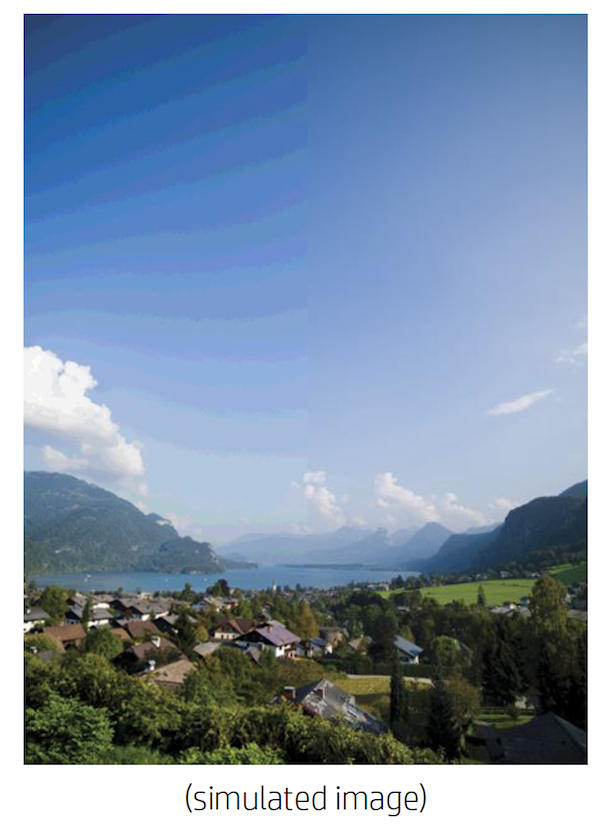As expected, but still exciting to see, another Next Wave production inkjet print technology has been introduced. This one is from HP, and it continues to show that they haven’t been sitting idle in the time since we last took a good look at their production inkjet offerings. Since that last article, they have introduced many new, and field upgradable, updates to their entire Inkjet Web Press product line. From the introduction of their first T-series press, HP has continued to develop and enhance its product lineup, in addition to assuring their customers that the press they purchased was designed to be field upgradable in order to protect their investments. This new introduction of High Definition Nozzle Architecture follows in that same tradition.
With the introduction and installation of the first HP T300 press at O’Neil Data Systems on December 24 2008, HP’s customers have now produced over 90 billion pages, with 36 billion of those in 2014 at a current run rate of nearly four billion pages per month. HP’s tenure in the market and extensive portfolio has provided a cumulative page capacity with the installed machines of about 160 billion pages per year. That includes about 57% of the total inkjet book pages printed world-wide. And while there are about 23 trillion book pages printed globally with offset, HDNA should enhance HP and their customers’ ability to capture more of that total. And the new technology HP has just disclosed will extend the use of HP production inkjet presses into many new application areas that have higher quality requirements.
In the past, HP upgrades focused on increases in speed and productivity for each of their base platforms. While this upgrade also addresses productivity, more importantly it addresses image quality with the introduction of a new print head technology.
HP imaging and the new technology
The big news for HP and its new and existing customer base is a significant upgrade in their print head technology. The new HDNA (High Definition Nozzle Architecture) print head highlights the next generation of HP’s long-standing expertise in thermal inkjet. The HDNA print heads provide an impressive density of 2400 nozzles per inch, per color on single color print head. Each print head contains 21,120 nozzles that are divided between 2 separate chambers with each chamber supplying the ink to 10,560 nozzles. These heads can be used for 2 colors, or a single color with even more nozzle redundancy. All of this is packaged into the same print head backend assembly to enable the existing machines in the field to be upgraded.

However, even more interesting is that the nozzles were architected based on a new dual drop technology. The nozzles are divided into a high drop weight nozzle and a lower drop weight nozzle, which is actually a tiny low drop weight (LDW) nozzle placed in between the high drop weight (HDW) nozzles. This interesting new head configuration brings with it support for 5 levels of grey per pixel, affording better color addressability throughout the color gamut while using the same HP A50 process inks currently in use today. According to Ross Allen, Sr. Technical Specialist with HP’s IHPS (Inkjet High-speed Production Solutions), “with the new HDNA print heads, we print with 1200 nozzles/inch each for LDW and HDW nozzles across the web in Quality Mode, and 600 dpi down the web. The arrays of LDW and HDW nozzles are slightly staggered since they are interleaved. In Production mode at 800 fpm, only the HDW nozzles are used.”
If you are familiar with inkjet printing, you know that getting smoothness in tone gradations across the gamut, especially in blends, fleshtones, and in lighter colors without getting that grainy look can be accomplished with two technologies: by adding a capability to print smaller drops or by adding light colors to the mix, ie; Light Cyan, Light Magenta, Light Black, etc., in addition to the standard CMYK. Both techniques produce lower-contrast dots that appear less grainy against the white background than full-density, full-size CMYK dots. What HP has done is take the small drop / large drop approach using the standard four process colors. From the samples I have seen, the blends and fleshtones are exceptional and equal to or better than the output of other production inkjet presses I have seen.
The example below is an HP supplied capture of one of the actual printed samples I received. You can see an enlarged section of a B&W photo image highlighting the tone advantage of the dual drop technology. The packet of samples showed a range of substantive benefits of this new technology.

This advantage also carries over to full color print as seen by the simulated comparison of their current print head output (on the left side of the image below) against the new HDNA output. As a result of the dual drop technology it is able to suppress tone breaks (banding). HDNA’s ability to print more colors directly gives increased color resolution inside the gamut to provide better highlight and shadow detail, perhaps difficult to see here, but evident in the samples I reviewed.

Additionally this new print head architecture allows for an increase in productivity. On the HP T400 platform this translates into 400 fpm in quality mode and 800 fpm in black and color in performance mode, a 33% increase over today’s 600 fpm print capability.
We probably shouldn’t be too surprised by this innovation. Since the introduction of HP Scalable Printing technology in 2006, HP has developed new print head generations using common design rules, materials, and manufacturing processes based on integrated circuit fabrication. This has allowed them to extend the modularity of the design across all of their inkjet products, leveraging R&D efforts across different product lines. They are also one of the only production printer manufacturers that have vertically integrated in-house R&D over the core technology of the press design and manufacturing, including print heads, ink, dryers, media, software and firmware, print servers, image processing, and other solution innovations.
At the core of HP’s imaging process is a thermofluidic process, where “nothing moves but the ink itself.” In the print heads, a tiny heater vaporizes a thin film of ink. A vapor bubble fills the chamber like a piston to force ink through a nozzle. Air bubbles are also forced out on every drop ejection cycle for reliable operation. And now, with HDNA, HP places 2400 nozzles per column inch. The design includes a fault tolerance system that compensates for any faulty nozzles with multiple nozzles printing in the same dot-row down the web. The presses use HP developed and manufactured water-based pigment inks. HP has also has a MICR option, with a specially designed HP print head and ink.
One of the more important examples is the HP Advanced Image Pipeline Processing that was introduced on their T-series presses early on. This modular electronic architecture is scalable to different press widths, speeds, and mono/color capabilities and allows data to be processed into print head drop commands to support the press speeds. The HDNA print heads will require an update to the Advanced Image Pipeline Processing, which would include new print bars, wiring, and new controller as a part of the upgrade package.
In the T-series production presses, HP uses water-based inks, which have very low VOC emissions, are non-flammable and non-combustible, and with no hazardous air pollutants. Since water is a major component of the ink, it does create the potential for other issues. All inks, even the inks used in offset printing, need to ‘bond’ to the substrate to create a good adhesion. If the bonding didn’t occur, the ink would easily rub off. Since water-based inks can and will absorb into many non-treated substrates, HP has used an optional ‘Bonding Agent’ inline to pretreat uncoated and coated standard offset papers at every pixel where the pigment ink will print. HP has also added an optional HP Priming Agent for coated media to expand the available substrates that can be run. Unlike Bonding Agent, which gets applied by inkjet heads in the press, the priming agent is a flood coat applied by a roller in a separate coater.
However, in order to support the growing production inkjet market, paper manufacturers are continuing to produce an increasingly wide range of inkjet compatible papers. Currently there are more than 120 ColorPRO papers. These papers do not require the use of a bonding or priming agent, and in fact can produce better reproductions as well. While it can vary depending on coverage, the use of a bonding and priming agents can also lead to lower costs than purchasing pretreated substrates.
Transport Update
As an update to the last article, HP’s current lineup starts with the T200 family, with a 20.5-inch printable width T200, which prints at up to 400 fpm (ft/minute) in monochrome and 200 fpm in full color, and the T230 is an optional upgrade to print up to 400 fpm in full color. They both support paper widths from 8 to 22 inches with a printable frame length from 11 to 72 inches. In 2014, HP also introduced the T260 Mono Inkjet Web Press with a 24.88” print width and 26” paper path, which prints up to 800 fpm in monochrome.
In the midrange, HP offers the T300 family, which has a 29.1-inch print width on up to a 30-inch wide web. The series includes the T300 which prints up to 400 fpm in full color, the T350 which prints up to 600 fpm in full color, and the T360 which prints at 600 fpm in full color and 800 fpm in monochrome.
At the top of their commercial print line is the T400 family which has a printable width of 41.75 inches on a web width of up to 42 inches. This family consists of the T400, which prints full color at up to either 400 or 600 fpm depending the version chosen. At the top of the line is the T410, which can print full color at up to 600 fpm and monochrome at 800 fpm.
Recently they also introduced a high speed Inkjet Corrugated Packaging Solution. One of the first of its kind, this is a simplex version of the T400 press, printing at up to 600 fpm that supports printing on papers that will be laminated onto a corrugated base.
All of HP’s production inkjet presses can print 100% variable data content at full press speed. The T200 family supports media weights from 60-215 gsm, while the others support 60-350 gsm.
Front End
The front end driving these presses is the HP SmartStream Production Elite Print Server. Since HP is also a server manufacturer, the system is based on its own hardware architecture. At the heart is a Global Graphics Harlequin RIP, which can support most of the standard PDF/X formats, PDF/VT, and AFP/IPDS with a third-party solution. The ability to manage the press, as well as any incoming static or variable jobs at machine rated speeds requires a very powerful and scalable computing system.
Depending upon which press you choose as well as your workflow levels and job requirements from mono text to full-color images, the digital front end can be configured (and upgraded) to meet the most demanding requirements with the capability to install the number of servers based on the customer’s job type – from simple commercial jobs to short-run publishing to complex variable data printing applications.
Conclusion
HP will be announcing their first beta site later this year for an HDNA press. They expect the new presses to be available in 2016, with implementations of the other families and upgrades availability following close behind. All previously released models, except the T260, which was designed for monochrome printing, are field-upgradable. HP believes their T-series presses should have a production life in excess of 10 years.
With the introduction of HDNA technology, HP has addressed many of the concerns of those looking to migrate from offset or toner. From a quality standpoint, this provides much more vibrant colors with a higher optical density. It also produces much smoother halftones and blends, something that existing T series clients have been clamoring for.
Recently HP announced that Quad/Graphics has over 20 HP Color Inkjet Web Presses in their 3-year transformational plan, with the first five presses to be installed in 2015. One can only assume that this new HDNA technology played a part in their decision.
It seems like the pace of new Next Wave Production Inkjet press introductions is picking up. In fact, I expect that there will be more introductions around the Hunkeler Innovation Days event later this month. Stay tuned for more exciting announcements…















Discussion
By Cory Sawatzki on Feb 09, 2015
Hey David, Any concept of price for the T-300?
By David L. Zwang on Feb 09, 2015
Hi Cory. As with most of these Production Inkjet presses, there are config variables (sounds like a salesman story???). I'm sure someone from HP would be happy to answer.
By Thomas Lickert on Apr 25, 2015
David I find your articles about Production Inkjet fascinating. I want to thank you for connecting the dots in the Inkjet World.
I appreciate your help.
Thomas Lickert
Simprint
[email protected]
By David L. Zwang on Apr 25, 2015
your welcome... Production Inkjet adoption has ramped up as the technology and product offerings have started to catch up to more of the print market requirements. It's going to be very interesting over the next few years!